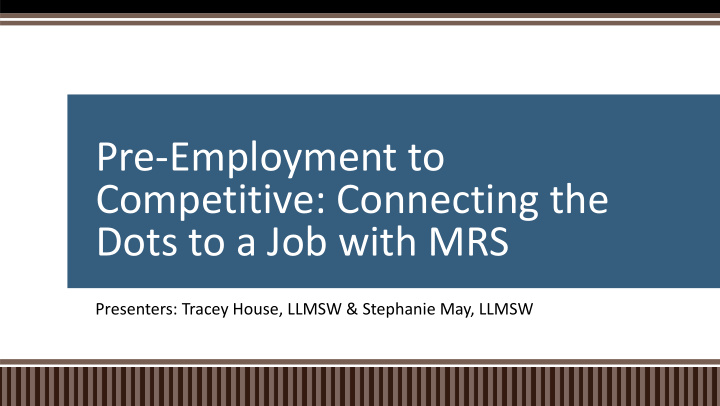



Pre-Employment to Competitive: Connecting the Dots to a Job with MRS Presenters: Tracey House, LLMSW & Stephanie May, LLMSW
Objectives Key Differences between Pre-Employment to Competitive Levels of MRS Service Making Pre-Employment services work for your students How to assist transition aged youth with landing competitive, unsubsidized employment
Know the Lingo MRS case types – PTA: Prior to Application Open to students in secondary education with IEP/504 – VR: Vocational Rehabilitation Complete full MRS application Eligibility determination Services provided under Individualized Plan for Employment (IPE) Pre-Employment Transition Services (Pre-ETS) – Available under PTA or VR to students with a disability
Workforce Innovation and Opportunity Act (WIOA) Section 422: Pre-Employment Transition Services – Each State shall ensure that the designated State unit, in collaboration with the local educational agencies involved, shall provide, or arrange for the provision of, pre-employment transition services for all students with disabilities in need of such services who are eligible or potentially eligible for services under this title.
Who is eligible for Pre-ETS Services? Student with a disability – Between 14 and 26 years of age – Attending a secondary or postsecondary education program – Receiving special education services, or is an individual with a disability for purposes of 504 eligibility.
Pre-Employment Transition Services (Pre-ETS) 5 Categories – Job Exploration – Work-Based Learning Experience – Counseling on Post-Secondary Education – Workplace Readiness Training – Self-Advocacy Training, including Peer Mentoring
Job Exploration Career Inventories (CareerScope/Career Assessment Inventory) Informational Interviews Career Day-Guest Speakers from various professions Career awareness Workshops & Seminars
Work-Based Learning Experience Job Shadows Internships (paid or unpaid) Career Mentorships Apprenticeships On-the-job training (OJT) Trial Work Used to provide students an opportunity to gain hands-on workplace experience and gain transferable skills. Not used as a “filler” for students who are work ready.
Counseling on Post-Secondary Education College and MCTI Tours College Success Workshop College applications, FAFSA Counseling on various training options including certifications, degrees, trade programs How to access accommodations in post-secondary setting
Workplace Readiness Training Soft skills (Communication, Attitude, Teamwork, Professionalism, etc) Employability Completing applications, resume writing, interviewing Financial Literacy On-the-job evaluations Work or personal adjustment
Self-Advocacy Training, Including Peer Mentoring Disability Disclosure and self-advocacy Leadership Training Peer mentoring and guidance
Examples that DO NOT fall under Pre-Employment Services… Competitive, Integrated Employment Job Coaching Tuition Books and other course material Assistive Technology Psychology Evaluations Transportation Assessments
Completing PTA and Referring to VR Once it has been determined a student with a disability has been provided the services designed with PTA of an early start at job exploration to assist them in making the transition from education/training to competitive, integrated employment
How can Pre-ETS lead to successful VR outcomes? Job Exploration: – Students can complete interest inventories, participate in job shadows and informational interviews to narrow career interest – Leads to more developed vocational goal for IPE Self-Advocacy – Students learn to advocate for themselves and seek necessary accommodations for both post-secondary training and employment
How can Pre-ETS lead to successful VR outcomes? Work Readiness – Students provided training on resume writing, how to fill out job applications, interview skills – All necessary skills for obtaining competitive, integrated employment – Less up-front work with job developer and can move to looking for employment more quickly and independently
How can Pre-ETS lead to successful VR outcomes? Work Readiness: Soft Skills – Some of the top skills employers look for: Communication Time Management Teamwork Problem-Solving and Critical Thinking – Often provided in group setting to provide opportunity to learn from peers and practice interpersonal skills.
How can Pre-ETS lead to successful VR outcomes? Work-Based Learning Experience – Gain foundational work skills Transferable skills – Add to resume – Develop connections for potential references – Learn about likes/dislikes, strengths, abilities, areas for improvement – Practice with self-advocacy and asking for accommodations if needed
Work Based Learning Experience Example Handout – PTA from VR Evaluation PTA – same experience, expectations but not being evaluated for assessment purposes but more of a learning process VR – use as an assessment purpose for eligibility and can have recommendations for next steps
How can Pre-ETS lead to successful VR outcomes? Counseling on Post-Secondary Education – Provides students with an opportunity to learn about potential options such as college, MCTI, certifications, apprenticeships, etc. – Assists with development of more concise IPE and services to be provided
Collaboration IS KEY Families and students School Transition Coordinators and Teacher Consultants Vendors PTA and VR Counselors
Collaborating with Families and Students Orientation process – In Groups or Individually, students hear about MRS services from their assigned MRS Counselor – Consent forms sent home for students under the age of 18 – Movement toward more parent involvement in services for minors/those with guardians January 2020: Pre-ETS Service Agreement Counselors often attend Parent Nights, Parent-Teacher Conferences, and other school events to share MRS information with families
Collaborating with School Transition Coordinators and Teacher Consultants Meet with staff at beginning of school year to discuss programming Attend IEP Meetings and school events Coordinate orientations for students with school support Consistency throughout district for required paperwork and expectations
Collaborating with Vendors Open communication Clear expectations Sharing of ideas for new programs Inclusion of vendors into planning of programs
Collaboration Between PTA and VR Counselors Understanding what each other’s roles are Creating clear lines as to when to move student to VR case Warm handoff of cases who have been active in pre-ets services when moving to VR so families are well informed and involved in process
Contact Information: Tracey House, LLMSW 734-677-1140 HouseT1@Michigan.gov Stephanie May, LLMSW 734-677-7505 MayS5@Michigan.gov
Recommend
More recommend